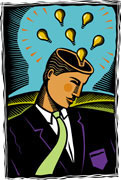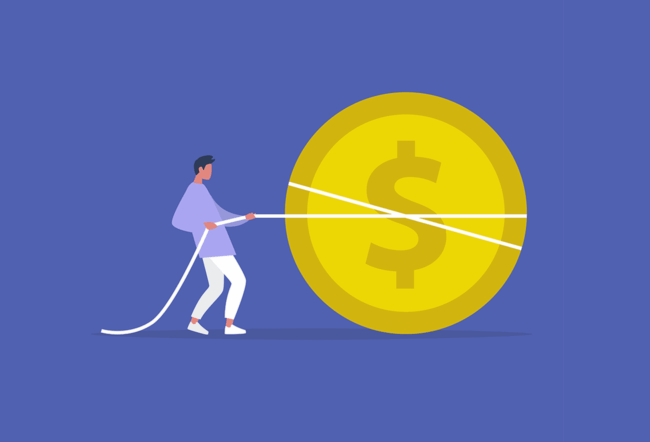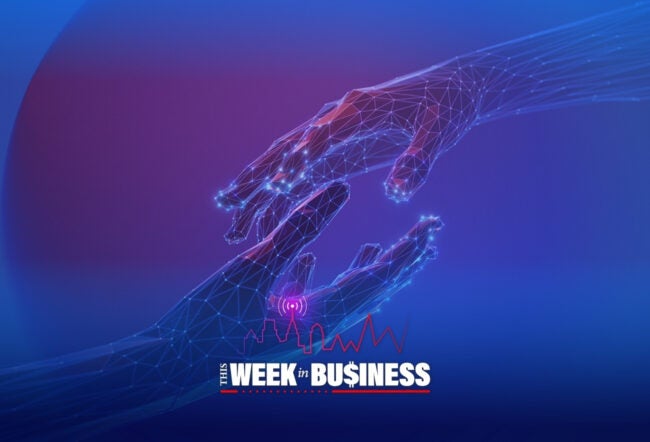Is the promise of potentially lucrative commercialization enough to lure software hackers out from the underground? What drives the vast pricing differences in the Medigap market? Can more finely tuned online ranking systems help consumers get better value from their hotel choices? Wharton professors Ethan Mollick and Amanda Starc and visiting professor Anindya Ghose, respectively, offer answers to these questions in their latest research.
For Creative Types, It’s Not Always about the Money
In the 1987 movie Wall Street, the character Gordon Gekko famously declared that “greed is good,” a line that has come to symbolize the darkest aspects of materialism. But the latest research from Wharton management professor Ethan Mollick sheds light on that bleak outlook and shows that not everyone is in it for the money.
In his paper titled, “Filthy Lucre: What Motivates the Commercialization of Innovation,” Mollick posits that financial gain sometimes plays little to no role in the decision making of highly creative people. In fact, the desire to stay out of the market can even smother some people’s career aspirations.
Mollick builds his theory around a study of one of the most successful product launches of all time — Apple’s iPhone. When the long anticipated device was finally released in 2007, many of the technological innovations that developed around it — specifically, novel user applications, or “apps” — were incubated underground, providing an excellent environment to examine the notion that some innovators are motivated by more than material gain. “Part of the reason that the commercialization decision has been understudied is due to the difficulty of finding nascent entrepreneurs and potential innovators before they decide to commercialize,” Mollick writes. “I identified a natural experiment associated with the launch of the iPhone that allowed me to sidestep this problem.” He adds: “This is an especially compelling sample because of the importance of the innovations developed by the individuals in the sample. In addition to eventually starting a number of successful ventures, these innovators developed key new software categories for the iOS platform: the first photography applications, the first games, the first electronic reading applications and many others.”
For the first year after its release, the iPhone was a closed system with proprietary software designed and licensed only by Apple. But almost as soon as the product was on the shelves, hackers were busy developing free, unlicensed software and an underground distribution system for users who wanted to modify their phones. This process, called “jailbreaking,” was done to an estimated 25% of the millions of iPhones sold, Mollick notes, despite the fact that installing outside applications would void the warranty from Apple.
A year later, Apple unveiled the second-generation iPhone and a new “app store” to sell applications that were legally developed for the smartphone. The company also invited hackers to go straight by selling their pirated software through the app store. It was a sweet deal for those looking to capitalize on their work. Apple would handle all marketing and distribution, while developers collected 70% of sales revenue.
Hackers had three choices: They could continue their commitment to staying underground, update their software under Apple’s watchful eye and commercialize their work through the app store, or abandon their project. “It turns out it’s a complicated dance,” Mollick says. “It’s a lot about freedom. Hackers found [Apple’s] closed system bad, but they found Apple [products] elegant. They were motivated by the aesthetic beauty. Innovation is art to these people. So when you dump a bunch of cash on the table, does that change their behavior? For some it does. But you’d be surprised that some do not shift. They leave the cash on the table.”
In his paper, Mollick notes that the stakes were high for commercializing: One group of underground developers sold their firm to Walt Disney Company for more than $40 million. “Thus, it would be entirely rational to expect individuals, with almost no opportunity cost and essentially complete products, to pursue commercialization.”
Mollick identified 158 “jailbroken” applications for the study and spent several years tracking down the hackers. He found 88 applications were abandoned by the inventor, 35 were kept free and 35 were eventually commercialized. Among the 88 developers, 32 ultimately abandoned their development efforts altogether, 19 continued to develop only free software and 37 commercialized by selling at least one piece of software — including eight developers who created new applications that were sold on Apple’s app store.
The results of the study bolster the argument that some innovators do not respond to economic incentives. For many, innovation is about solving problems, such as a parent who comes up with a novel idea for dealing with picky eaters at dinner time. For others, it’s about creating the best possible product, such as the winery that stays small in order to maintain quality control. And for some, including hackers, the reasoning is far more elusive. “A lot of people sell out when given a chance,” Mollick notes. “But the ones who sell out are not always the ones you’d expect. They are not always the ones who are most innovative.”
Mollick says more research in this area could be useful for companies looking for a new approach to the next big thing. What’s important, he notes, is “thinking hard about what motivates people. It’s about understanding who you are trying to talk to and getting them engaged. People are innovating around products all the time. Reaching them is not just about cash; it’s about understanding what these communities want.”
Learn more about Mollick’s research in this area by watching the video below:
Demystifying Medigap Pricing
In the murky, often misunderstood world of insurance, there’s one product that seems especially vexing for consumers — Medicare Supplement Insurance. Commonly referred to as “Medigap,” these policies are sold by private insurers to help elderly Americans pay for services not covered by their Medicare plans.
The Medigap market is highly regulated, with standardized policies that are contractually identical whether they are purchased in Houston or Honolulu. Yet there are dramatic price differences across the country, and the markup between premiums charged and the claims paid by insurers is nearly 30%, which is about 15% higher than federal guidelines. However, new research conducted by Amanda Starc, a professor of health care management at Wharton, helps to explain what drives the pricing in this mysterious market.
In her paper titled, “Insurer Pricing and Consumer Welfare: Evidence from Medigap,” Starc shares some surprising results from data analysis that can help shape public policy in the larger debate on health care reform.
Unlike automobile insurance policies, which are highly differentiated and offered by myriad providers, Medigap policies are far less competitive. Starc found that only two companies — UnitedHealth and Mutual of Omaha — control three-fourths of the market. Also, the market is inherently unique because there is low price elasticity. In other words, fluctuations in price have little effect on the demand for the product.
“Insurance policies are complicated financial products, and it is extremely difficult for average Americans, let alone a potentially vulnerable and less technology-savvy group of elderly Americans, to understand or research all of the contractual details,” Starc writes in her paper. “Consumers are willing to pay more for insurance from a ‘trusted name,’ potentially driving up premiums as consumers trade off brand preferences for price.”
To conduct her analysis of what factors most influence Medigap pricing, Starc used market level data from the National Association of Insurance Commissioners, which compiles information on premiums, quantities of new policies sold and claims. She augmented that data with consumer-level information from the Medicare Current Beneficiary Survey. The survey provides data on demographics, coverage and expenditures for a national sample of Medicare recipients. She also looked at the marketing and related expenses incurred by companies selling Medigap policies.
According to Starc, many industry analysts blame high premiums on a phenomenon known as “adverse selection” — a market failure that happens when insurance sellers don’t have as much information as their buyers. For example, a policy becomes less profitable for the insurance company if the provider is unaware of a customer’s preexisting health condition. That health condition could result in higher claims that need to be paid out for that policy holder, compared with policies purchased by healthier people. To compensate for adverse selection, insurers often increase prices to cover the difference.
Adverse selection is an important factor in what drives up prices for Medigap insurance, but Starc discovered that it is not the most powerful force acting on prices. That distinction goes to the expensive marketing efforts undertaken by the policy providers. Consumers rely so much on brand preference in picking out Medigap policies, she notes, that companies must invest heavily in marketing and advertising. “What I ended up finding is that market power is much more detrimental to consumers than adverse selection.”
She illustrates her point with an example from UnitedHealth. In 2008, the company paid $222 million to the AARP to display the nonprofit senior advocacy group’s “seal of approval” on UnitedHealth’s Medigap products. “So if you’re watching television at 3 o’clock in the afternoon, you’ll see an ad for supplemental insurance [with the AARP] telling you that you should buy it,” Starc says. “That strategy is very expensive. Nobody else is going to use that strategy.”
By contrast, the second-largest provider of Medigap insurance, Mutual of Omaha, sends out a fleet of brokers to sell policies directly to consumers. “Suddenly, that 30% wedge between the premiums and what is being paid out is being captured in marketing the policy,” Starc points out. “It is expensive to sell this stuff.”
Starc cautions that her research is not meant to imply that insurers are exploiting their customers. Rather, her study stands as evidence that the market should be regulated differently. To change market outcomes significantly, she says, public policy needs to find an instrument that shifts consumer preferences to other kinds of criteria beyond brand. “The prices are high because the cost of selling the policy is so high…. Deregulating this market would be all well and good when there is no market failure. But there is market failure, so that justifies some action.”
She hopes her research will prompt more education and awareness programs for consumers to help them make better choices that are based on more than just infomercials or sales brochures. That education could come from public agencies, nonprofits or the insurance providers themselves. “We want to take the choice process and make it as simple as possible so consumers aren’t making mistakes,” Starc says.
The Travel Search Engine That Thinks the Way You Do
When planning a vacation or business trip, consumers rarely choose a hotel for just one reason. Usually, the lodgings chosen offer a combination of features that the individual considers important, whether that is price, location or amenities.
But the search functions on most online travel sites typically only allow users to filter based on one of those factors. In a new paper, Anindya Ghose, a visiting professor at Wharton, and co-authors Panagiotis G. Ipeirotis and Beibei Li of New York University’s Stern School of Business address this disconnect by employing user-generated content from the Internet to build a new ranking system that recommends products based on which ones will provide the overall best return on investment (i.e., highest value for the money spent) for the consumer.
Ghose, who is also a professor at NYU’s Stern School of Business, uses the example of a hypothetical week-long trip to Miami to illustrate the challenge of making online hotel reservations that fulfill a complex set of preferences. “Let’s say it’s a pleasure trip, so I’m interested in a hotel that is close to the beach, but is also close to areas with lots of nightlife, has a golf resort on the premises and is not too far from an airport and public transportation,” he says. “None of the current search engines have an easy way — or any way, for that matter — of answering all of those questions. You would have to sift through hundreds of reviews and social media sites.”
Indeed, he adds that most product search engines, whether they are being used for hotel reservations or buying electronics, typically force customers to focus their query on just one characteristic or dimension. “This rudimentary approach largely ignores consumer heterogeneity and their multi-dimensional product preferences,” the authors write in their paper, “Designing Ranking Systems for Hotels on Travel Search Engines by Mining User-Generated and Crowd-Sourced Content,” which is forthcoming in the journal Marketing Science.
Often, consumers will supplement whatever information they get from a search engine by reading online product reviews or asking people in their social networks to offer recommendations. This is particularly true of the hotel industry: The paper quotes a study by ComScore, which found that more than 87% of customers rely on online user-generated content to pick a hotel — higher than any other product category.
But Ghose points out that, for most people, supplementing their search in this way is much more complicated than checking each hotel’s website or reading the first half dozen or so reviews of a particular spot. Preferences vary wildly according to a person’s financial and personal circumstances (whether they are traveling for business or pleasure, for example, or with children or without), and a consumer might have to sift through pages and pages of reviews to find entries by people whose situations are similar to theirs. Moreover, “sometimes even hotels don’t know the dimensions of their business that people seem to value most,” Ghose adds.
To create their new ranking system, the researchers used information on hotel reservations made on Travelocity.com over a three month period in 2008 and 2009, along with user-generated content from three sources: hotel reviews from Travelocity and TripAdvisor; social-geo tags posted to Geonames.org by users identifying features of hotels, and opinions about important hotel characteristics that were gathered via surveys on Amazon Mechanical Turk. “We then merge these different data sources to create one comprehensive dataset summarizing the location and service characteristics of all hotels,” the researchers write.
They identified five key characteristics that have a positive effect on hotel demand: number of external amenities and proximity to a beach, public transportation, highways and a downtown area. Business travelers were the least price conscious when making reservations and placed a high value on closeness to a highway or public transportation. Tourists were the most price sensitive, while “romance” travelers mostly valued hotels closer to a beach and those with an excellent rating for customer service.
Using the ranking system developed by the researchers, a consumer conducting a search for hotels would be prompted to check boxes to denote which features are most attractive to him or her; for repeat users, the search engine would take past transactions into account. The subsequent search results would use all of a consumer’s noted preferences to rank hotels based on which ones would “give you the most ‘bang for your buck’ or the highest net utility gain,” Ghose says. “Essentially, instead of just looking at the price, we’re looking at the net return on your investment [in a particular hotel,] which is a function of all the … internal and external features a hotel provides to you.”
According to Ghose, the model could apply to any product where consumers take multiple dimensions into consideration when making a decision. “How personalized we can get depends on the data,” he notes. “It’s a trade-off. If you give us more information, then there is an incremental increase in precision…. Just by giving a little bit more information, we can make the recommendations a lot more precise.”



